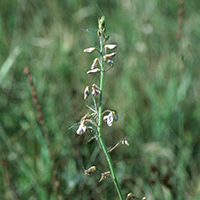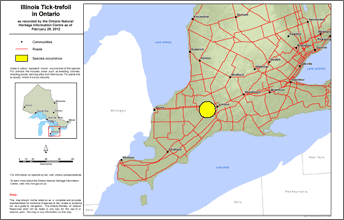Illinois tick-trefoil
Scientific name: Desmodium illinoense

Cover photo credit: Allen Woodliffe
Status
Extirpated
“ Extirpated ” means the species lives somewhere in the world, and at one time lived in the wild in Ontario, but no longer lives in the wild in Ontario.
Date added to the Species at Risk in Ontario List
The Illinois Tick-trefoil was already listed as extirpated when the Endangered Species Act took effect in 2008.
What it looks like
Illinois Tick-trefoil is a tall erect perennial herb in the pea family. Plants grow to about two metres. Leaves are three-parted with lance-shaped leaflets covered on both sides with hooked hairs that produce a rough texture. The blossom is an open, elongated terminal cluster of flowers, occasionally branched. Flowers are five-parted with two upper lobes and three lower. They are white, to pink in colour. The fruit is a flat seed pod divided into two to five segments and covered with hooked, clinging hairs.
Where it lives
The Illinois Tick-trefoil is a tallgrass prairie species that grows in dry to moderately moist rich soils. It colonizes grassland areas opened up by burning or disturbance.
Where it’s been found in Ontario
Illinois Tick-trefoil was collected in 1888 at one location near London in southwestern Ontario. It has not been reported since. The species may still occur in Ontario in remaining patches of dry prairie habitat in southwestern Ontario.
Illinois Tick-trefoil is found in north-central United States from southern Michigan west to southeast South Dakota, and south to northern Texas, Oklahoma, northern Arkansas and southern Illinois. It is believed to be extirpated in Ohio.
View a Larger version of this map (PDF)
Why it disappeared from Ontario
This plant likely disappeared due to grazing, mowing, and the conversion of tallgrass prairie to agriculture.
Action we are taking
Extirpated species and their habitat are protected if the species are again found in Ontario.
Help Make Sure We Don’t Lose More Endangered Species in Ontario
- the Ministry of Natural Resources tracks species at risk such as the Illinois Tick-trefoil. You can use a handy online form to report your sightings to the Natural Heritage Information Centre. Photographs with specific locations or mapping coordinates are always helpful
- report any illegal activity related to plants and wildlife to 1-877-TIPS-MNR (847-7667)
- private land owners have an important role to play in species recovery. You may be eligible for stewardship programs that support the protection and recovery of species at risk and their habitats
- many species at risk depend on healthy grassland prairies, a very rare habitat in Ontario. Learn more about these habitats, the species that depend on them, and what you can do to help at www.tallgrassontario.org
- the Carolinian forests of southern Ontario support an amazing diversity of plants and wildlife, including many species at risk. Carolinian Canada is working to help recover species at risk and their habitats. For more information, visit: www.carolinian.org/SpeciesHabitats.htm
- volunteer with a local nature club or provincial park to participate in surveys or stewardship work focused on species at risk
Quick facts
- Illinois Tick-trefoil has explosive blossoms, which means that when a bee or butterfly stops on a flower, a cloud of pollen is shot at it
- Tick-trefoil plants are named for their seeds, which stick to clothing like ticks, and for their three-leaf arrangement
